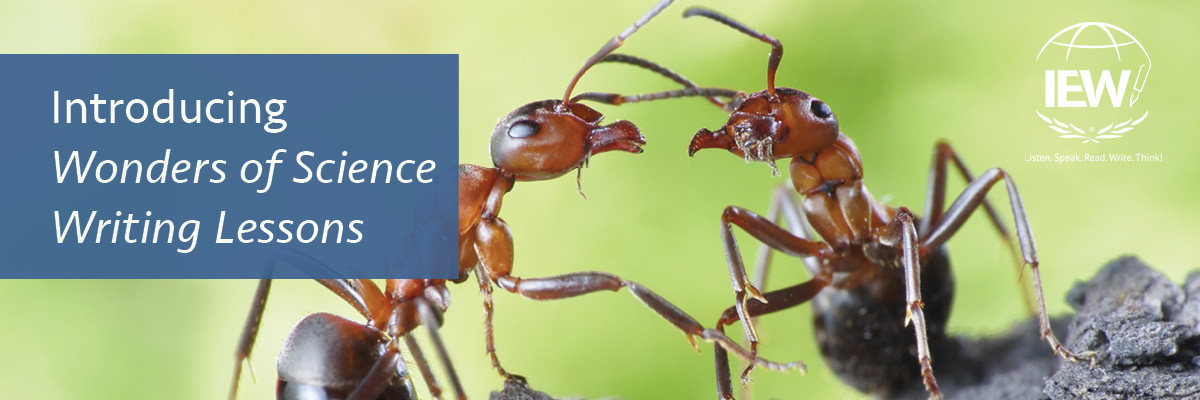
How are astronauts protected from space dust traveling at the speed of a bullet? How do ants know when another ant has died? Which woman scientist was called the Sun Queen and why? All these questions and many more are answered in the Wonders of Science Writing Lessons.
Wonders of Science Writing Lessons is IEW’s newest theme-based lesson book and covers all nine units of IEW’s Structure and Style writing method (note taking, writing from notes, retelling narrative stories, summarizing a reference, writing from pictures, summarizing multiple references, inventive writing, formal essay models, and formal critiques) to help students organize any type of composition.
For students who savor science, Wonders of Science will be the perfect fit! Some of the included topics are bombardier beetles, Maria Telkes, and favorite inventions. Students will revel in retelling the stories of Jack and the Beanstalk and Archimedes. Do you have students who dream about what would happen if a meteorite fell nearby? What if they found a bottle with a message in it? This new theme-based book will ignite their creativity!
Each of the thirty carefully planned lessons begins with a suggested schedule and ends with a che cklist. The schedule breaks the concepts into bite-sized instruction. The checklist provides clear expectations for the writing assignment, ensuring easy grading for teachers and teaching parents.
cklist. The schedule breaks the concepts into bite-sized instruction. The checklist provides clear expectations for the writing assignment, ensuring easy grading for teachers and teaching parents.
In addition, each lesson includes the required source text(s), structure and style instruction, and vocabulary words. Providing ample practice for students as they learn and review dress-ups and sentence openers, writing exercises offer students many opportunities to play with words as they progress through the book.
Furthermore, students learn mechanics and grammar rules at the point of need. When prepositional phrases are required, students learn what they are, how to use them, and when they need commas. When students write a paragraph that includes numbers, they learn when to use numerals instead of words. When the students write a literary critique, they learn how to properly use quotation marks or italics for titles. Conveniently, a mechanics glossary is included in an appendix.
The appendix also includes vocabulary words, vocabulary quizzes, and suggested literature selections that coordinate with the lesson topics. The Teacher’s Manual, uniquely structured to help parents implement the Structure and Style writing method, provides manageable amounts of direct, explicit instruction for new and seasoned teachers and teaching parents. A special appendix in the Teacher’s Manual suggests review games to use with many lessons, making this a fun, practical book to use in a co-op or group setting.
The included downloads enhance this course.
- Reproducible Checklists
- Vocabulary Cards
- Simplified Source Texts
- Advanced Additions
- Exemplars
Wonders of Science is not intended for use as a science curriculum but rather is an excellent tool for broadening subject knowledge while teaching writing. This book fits within IEW’s Level A product line. If you have used IEW’s Ancient History-Based Writing Lessons, this book follows the same scope and sequence. Wonders of Science was designed specifically for students in grades 4–7. If you wish to use this course with younger students, plan to use the Simplified Source Texts for each lesson. For students older than sixth grade, the Advanced Additions will provide an added challenge.
If your students bring you birds’ nests and bugs or are always asking questions about science, add Wonders of Science Writing Lessons to your curriculum plan for next year!
|
Danielle Olander is an IEW® Accomplished Instructor. Married to her college sweetheart, Ray, and a homeschooling mom of five amazing children, she teaches several of IEW's online writing classes. After graduating from her parents’ homeschool in the pioneer days of homeschooling, Danielle graduated summa cum laude with her B.A. in English/History Education from Cornerstone University, Grand Rapids, Michigan. During and after college, she worked as a librarian’s assistant, which only increased her lifelong love of reading and writing as she discovered so many new means of locating fascinating facts.
|

